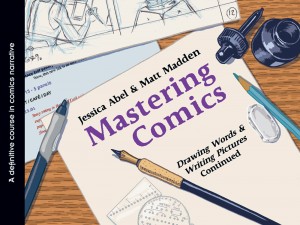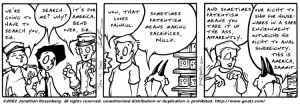No Twitter Meant Time To Get Some Thoughts Together
Who says that service outages are always a bad thing?
So I’ve been thinking about the possibilities for the Penny Arcade Strip Search Reality TV Series Thing since before I knew it was A Thing. Robert and Brian teased the crap out of it to me, never quite getting around to exactly what you might call details (and now that I reflect, it was probably one of the shoes waiting to drop that were left hanging back in Las Vegas). Since discovering it was A Thing (and Robert getting to see the look on my face, as he said he wanted to), I’ve been wondering where it could go.
Certainly, this is the sort of winnowing process that Robert Khoo lives for; many have commented that the hiring process for Penny Arcade is convoluted and demanding, bordering on insane¹, but I think most people who criticize have likely not been involved in personnel matters before. I’ve just wrapped up a four year stint as the Membership Trustee for my volunteer EMS agency, and I can tell you that Khoo is precisely correct that what makes for a bad hire is not a lack of skills, it’s a lack of fit (personally, culturally) in both directions. It’s the sort of thing that can kill a small business (or volunteer organization) if it’s not handled with extreme care, and more so when those environments are characterized as high-energy, high-pressure, or high-performance. If unpaid volunteers would have willingly subjected themselves to the multi-stage process that Khoo designed, I would have adopted it in a heartbeat.²
Since it’s a competition that needs to be visually interesting, I trust that Khoo will also be up to his usual standard in devising challenges (I’m pretty sure that Robert likes planning things like bachelor parties and reality competitions so that he — like a photographer that hates to be photographed — doesn’t end up participating in them). The demand will certainly be there, and the rewards certainly won’t be just for the eventually winner; the audience that could be built up by being followed for a season of PATV (some 30 episodes, I’d presume) and making it to the final three or four could be enough to launch a career, even without the year-long in-house association with PA’s experts.
I think that the ultimate success or failure of this project will hinge on two items: the breadth of work that gets in and stays in for the duration, and how well the contestants are nurtured.
In the case of the first, Mike and Jerry are terrific about pointing their readers to creators whose work is marvelously divergent from their own; can you think of any webcomicker less like Penny Arcade than, say, Erika Moen? Having an Erika-type, or analogues to the breadth of topic & style found in your Beckys, Kates, Merediths, Toms, Evans, or Jams in the contest, people whose work is nothing like Penny Arcade will, I think, be a prime determinator of the quality of competition.
This isn’t entirely up to the producer end of the equation — I do think that Mike, Jerry, Robert, and the others are fair-minded enough to want to showcase the best work with the most potential (after all, they’re on the hook to give a sort of imprimatur and don’t want to sully their own brand), but if the contestants self-select and you don’t get applications from as wide a pool of creators with as wide a range of artistic styles (and personal experiences), the show won’t live up to its potential with respect to (as Anton Ego put it) the discovery and defense of the new.
The second item is more within the control of the showrunner. TV does reality/competition shows on a range from generally classy (cf: The Amazing Race or Iron Chef America) to trainwreck (cf: Housewives, Shores, anything centered around a job that isn’t Ace of Cakes ’cause dammit, those people like each other and have fun at work), and even the shows on the ability counts more than narcissistic personality disorder end of the spectrum can drop the ball badly (cf: Mondo was robbed, and where is the goddamn owl).³ Put bluntly, will Strip Search have a Tim Gunn to encourage, critique, mentor (and, when needed, lay the smack down)? Note that unless the Tim Gunn role is fulfilled by Khoo, the local substitute will not be as good a dresser as Tim Gunn. Heck, just see if Tim wants to come out to Seattle for a couple of months.
So that’s where my head’s at. The rest we’ll see when the final numbers on the Kickstarter are in (as of this writing, we’re about US$1500 away from Jerry having to cosplay something suitably humiliating at PAXes Prime and East), but the projection makes Strip Search a virtual certainty at this point. Contestant screening, format, challenges, guest judges4 are all to be seen. There remains an incredible amount of work to execute on all the potential, but if there’s one thing the Penny Arcade crew (all of them, even the ones whose names you don’t see in the credits) know how to do, it’s execute on potential.
_______________
¹ Let’s make this clear: you or I could not get hired by Robert Khoo. We wouldn’t make it past the laundry question, much less to the phone interviews.
² Not that we ever had 5000 applicants for a single open EMT slot.
³ Confidential to Scott Kurtz: Project Runway has started again, so you might want to not pay attention to my tweets on Thursday nights for the next coupla’ months.
4 I could be available for a weekend, just sayin’.









